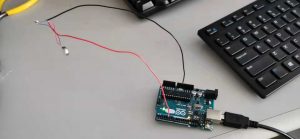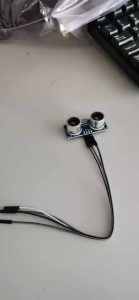This week, I focused on finishing up the arduino interface. I remodeled our pin assignment, since I found a way to use the analog pins provided to manage the trigger pins. As a result, we now have 18 pins in total that we can use, which satisfies our requirement. Furthermore, I was able to finish up the arduino interface and tested on operating 3 sensors and vibrators at the same time.I have concluded our work on arduino for now, and next week, I will focus on the python script in raspberrypi.
Xiaoran Lin’s Status report 2/26/2022
This week, my main focus is expanding our efforts on the arduino, and providing an arduino script that would be controlled using serial communication with python script. The system works well with a single sensor single vibration unit model, I was able to control the vibration and the on and off of the sensors through writing serial messages to the arduino. Furthermore, I was able to write a basic python script, that would communicate with the arduino to turn on the vibration unit whenever the sensors senses object <30cm, and turn off otherwise. We ran the script on raspberry pi and it worked well. I also tested connection and controlling multiple sensors with the same trigger pin, and it also worked.
One particular challenge I noticed was using pulseIn to receive multiple sensor information at the same time. In which I will have to read the source code and implement my own pulseIn
Next week, I will be increasing the scale of the arduino system to include all sensors and vibration units.
Team Status Report For 2/19/2022
This week, we reviewed our design process, and tested on an order of items that we received. The main progress includes the following:
Through talking to professor Gary and TA Joseph, we have added the use of arduino uno into our project. We will be using the arduino board to control both the ultrasonic sensors and the vibration motor disks. The updated design can be seen in the design review presentation, in which we will provide a detailed design on what our block diagram is now.
We have been able to test with both a single ultrasonic sensor and a single vibration motor disk with the arduino. We have found that the sensor we have purchased seems to work best within a 4 meter range. We did some real life testing with walking obstacles, and concluded that 4 meters is a reasonable range for our product. The vibration disks can operate from 2.2v to 3.8 volts, providing different levels of vibration. We tested with 3 levels of vibration using PWM pins on the arduino board, and we can make clear distinctions between the different levels of feedback. We therefore believe that this is enough for our users to receive different information on the level of threat present.


Setting up the main OS and testing the raspberry pi4. We were able to install the raspberry pi OS and test out its basic functionalities, mostly revolving around building python scripts needed. We also tested the serial communication between the raspberry pi and arduino. On a side note, when we were working with the raspberry pi4 in lab 1304, we were unable to properly connect the device to open network using CMU or CMU-DEVICE. For some reason, the internet always redirects us to the CMU-IT service network and we can’t navigate to outside networks such as google or Github, next week we will try to set up the environment with a home wifi instead.

We also did some basic video processing test with the OAK-D camera to see that it operates correctly. Ning Cao have been looking through the documentation to find out how we can best use the existing camera modules and processing power to our benefit
Overall, we have been focused on a proof of concept test this week to make sure that we have chosen the correct components and our general design idea can be achieved with what we have. We are in schedule as we have finished most of our setups and unit testing according to plan. Next week, we will be mainly working in three areas: sensor and vibration disk control with arduino(Xiaoran), raspberry pi integration(Kelton), OAK-D camera integration(Ning). Our individual reports will further illustrate our plans.
Xiaoran Lin report for 2/12/2022
This week, I have primarily been involved in deciding with the team what to purchase, and studying the OAK-D depth sensor camera modules online. We will be using the camera to process ground level information, and I am looking into online resources to help us utilize its functions
Team status report for 2/12/2022
Schedule update:
We have purchased and received most of our core components that we need to test, including the ultrasonic sensors, raspberry pi, and some various components. We are still waiting for our OAK-D depth cameras, but in general we are in time for testing our components.
No changes have been made to the schedule so far, next week, we will start testing our sensors and incorporating our raspberry pi into the system.
As for risks, the main part is whether the sensor models will be good enough for our purpose. This is something that we will be testing out next week, if they turn out to be insufficient, we have several backup sensors that we have been looking at, and we will purchase them immediately. If they do work, we will likely purchase more of the same sensors.
Xiaoran’s Status Report for 02/05/2022
This week I focused on working on the project proposal presentation with the team. We discussed the specific user requirements for our project and the additional features that we would like to add on top of the abstract. Me and Kelton met with Gary to discuss what we need to add and things that we need to fill out for the presentation.
